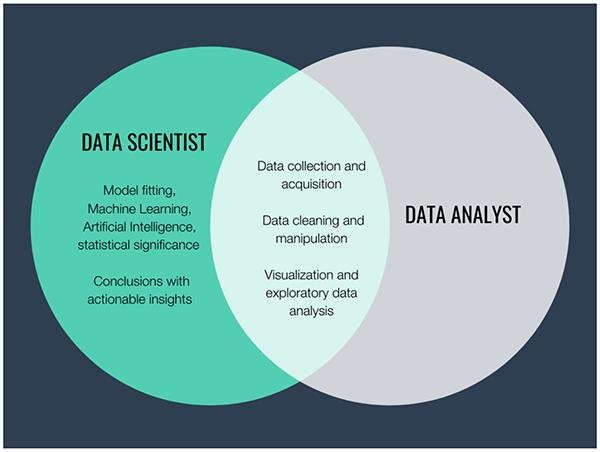Should I Become a Data Scientist or Data Analyst?
Written by Matt Dancho and Jarrell Chalmers

In order to determine where you wish to set your career trajectory, you need to understand the grey area and differences between data scientists and data analysts. The most “searchable” difference in these two careers is likely salary, such that those with the title of data scientist typically earn more than those with the title of data analyst. Why is this? This is best exemplified through understanding a general workflow of any data driven project:

- Stage 1: Data collection and acquisition
- Stage 2: Data cleaning and manipulation
- Stage 3: Visualization and exploratory data analysis
- Stage 4: Model fitting, Machine Learning, Artificial Intelligence, statistical significance testing
- Stage 5: Conclusions with actionable insights
Data analysts are typically seen working on stages 1, 2, and 3 whereas a data scientist is more likely to be needed at those stages of 4 and 5 which involve more industry specialized skills.
Depending on the size and scope of a company, a general purpose data scientist may be leading all five of these stages - something those in consulting work usually find themselves doing. However, in a perfect world these projects move at a faster pace and with more eyes searching for patterns and trends when the work of these five stages is divided amongst the analysts and scientists.
The easiest path is becoming a data analyst. These positions fall under a variety of roles or titles depending on the specific industry and company.
You’ll notice the stage which most commonly separates the analyst from the scientist is stage 4, which involves model fitting, machine learning, artificial intelligence, statistical significance testing, and other more advanced skills. This is where a data analyst often finds themselves out of their element. They might be able to acquire and transform data into a usable format, allowing for visualizations and running a few regression techniques. However, getting to that next level of involvings things like parameter adjustment and avoiding overfitting require the skill set of a data scientist.
Here’s how to go from analyst to data scientist
The biggest factor in turning your title of data analyst into one of a data scientist, is the refinement and acquisition of your skills along the way. The buzz word in the world of data science at this time is machine learning, which allows data scientists to leverage automated computational power of computers to go beyond what human “intuition” and rudimentary statistical analytics can enable us to learn about the insights within data.
Rather than considering costly graduate school degrees, full of dated materials and lessons unrelated to modern industry, you’ll want to engage in courses that teach you the skills you’ll need to upskill your resume and career trajectory. Check out our 5 Course Bundle-Machine Learning + Web Apps + Time Series.